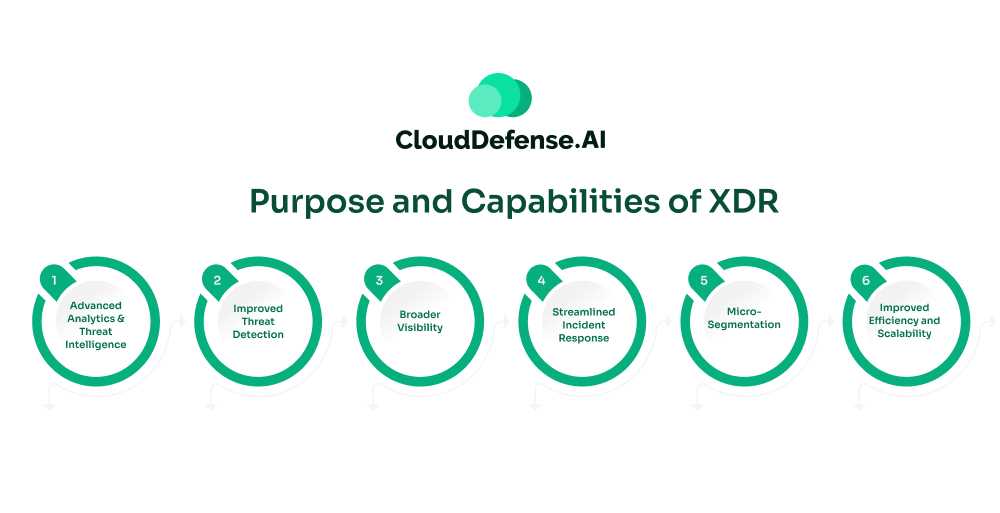If you’re trying to figure out whether XDR or SIEM is the right fit for your security stack, you’re not alone. A lot of companies are asking the same question — especially with threats evolving so fast and security budgets under pressure.
Both XDR and SIEM promise better visibility and faster threat detection, but they work in very different ways.
Here, let’s explore what XDR does, what SIEM does, how they compare, and which one (or both) actually makes sense for your business in 2025.
Understanding XDR
XDR (Extended Detection and Response) brings something every security team needs — a complete, connected view of threats across your entire environment.
Security teams today are juggling endpoint alerts, network signals, email threats, and cloud telemetry, all flowing into different tools that don’t always work together. That fragmented view slows down investigations, buries real threats under noise, and forces analysts to connect the dots manually.
To put it into perspective: if you’re relying on separate tools for endpoint detection (EDR), network monitoring, email security, and cloud threat visibility, ask yourself — are those tools really working together? Or are you and your analysts the glue trying to stitch together half-baked clues from ten different dashboards?
That’s exactly the gap XDR aims to solve.
What Exactly Does XDR Do?

At its core, XDR:
- Consolidates signals from endpoints, networks, emails, cloud workloads, and more — all into a single, correlated view.
- Applies cross-layer analytics to detect complex attack patterns that no single tool would catch alone.
- Automates response actions – from isolating compromised endpoints to blocking malicious IPs – directly from the same platform.
Why Does This Matter?
Think about your current SOC workflow:
- How many tools are feeding alerts into your SIEM?
- How often do analysts miss important connections between an endpoint alert and a suspicious email?
- How long does it take to piece together a full incident story across different systems?
With XDR, the goal is to shift from isolated detection to unified, context-rich threat stories — faster investigations, fewer missed threats, and less manual grunt work for your team.
Key Capabilities of XDR (That Actually Matter)
- Cross-Domain Correlation: Combines endpoint, network, email, and cloud data into one view — no more silos.
- Automated Threat Response: Built-in response actions (contain, quarantine, block) based on the full threat picture.
- Behavioral Analytics: Identifies subtle signs of compromise across users, devices, and systems — even if they evade signatures.
- Context Enrichment: Every alert includes the who, what, where, when, and how — no hunting for missing pieces.
If you are doubtful whether XDR can be of any help to you, here are the Critical Questions to Ask Yourself.
- How many alerts are you handling that lack full context?
- Do your detection tools “talk” to each other — or are you still correlating manually?
- When a threat spans endpoints, cloud apps, and email — can you see the whole kill chain or just one piece of it?
XDR isn’t just about adding more detection — it’s about replacing the fragmented, reactive workflow most teams are stuck with. If your team spends more time chasing alerts than stopping attacks, XDR is worth a hard look.
Understanding SIEM
SIEM (Security Information and Event Management) has been a core piece of enterprise security architecture for over a decade. It was designed to solve a fundamental problem — organizations generate massive amounts of security data across endpoints, servers, firewalls, identity systems, cloud platforms, and beyond. SIEM gives you a way to collect, normalize, and analyze all that data in one place.
What Does SIEM Do?
At its foundation, a SIEM platform handles:
- Log Collection: Ingests logs from across your environment — endpoints, firewalls, cloud platforms, identity providers, applications, and more.
- Log Normalization: Converts logs into a common format so you can search and analyze consistently.
- Correlation Rules: Detects known attack patterns or suspicious activity by linking related events across systems.
- Alerting: Generates alerts when specific conditions match predefined rules or threat indicators.
- Forensic Search: Lets analysts search through historical logs for investigation and incident response.
What SIEM Brings to the Table
- Centralized Log Storage: All security-relevant data lives in one place, which simplifies auditing and long-term investigation.
- Custom Detection Rules: Security teams can build their own detection logic tailored to their environment.
- Compliance Support: Many regulations (like PCI DSS, HIPAA, and GDPR) require centralized logging and log retention — SIEM delivers that.
But here’s the catch: Traditional SIEMs are only as good as the data you feed them — and the rules you write. Out of the box, they don’t automatically detect unknown or advanced threats. They also:
- Overwhelm teams with noisy alerts — if correlation rules are too broad, you get flooded with irrelevant alerts.
- Require constant tuning — log sources change, new apps get added, and detection rules need updating.
- Lack built-in response capabilities — SIEM tells you there’s a problem, but it can’t contain or mitigate it directly.
How SIEM Fits Into Your Security Stack?
Ask yourself:
- How much of your security data actually flows into your SIEM today?
- How many alerts in your SIEM lead to actionable investigations — and how many are noise?
- Is your SIEM helping detect real threats, or is it just a compliance checkbox?
Most modern security teams don’t rely on SIEM alone — they use it as a data aggregation and forensic tool, often pairing it with EDR, NDR, and now XDR for faster, automated detection and response.
XDR vs SIEM: Key Differences
If you’re trying to decide between XDR vs SIEM, you’re not alone. These tools both play important roles in modern security programs — but they solve very different problems, and choosing the wrong one (or expecting one to fully replace the other) sets your team up for frustration.
Core Purpose — What Problem Each Solves
- SIEM: Primarily built to collect, store, and correlate logs from across your environment for compliance, forensic investigations, and rule-based threat detection.
- XDR: Built to actively detect, correlate, and respond to advanced threats across endpoints, networks, cloud, email, and more — all in real time.
Data Handling — Collection & Correlation Approach
| Area | SIEM | XDR |
| Log Collection | Collects any log you configure it to ingest | Focused on security-relevant telemetry from endpoints, network, email, cloud |
| Normalization | Converts logs into standard format | Already pre-integrated across native sensors, reducing normalization work |
| Correlation | Uses manual correlation rules — prone to noise if not tuned well | Performs automatic cross-domain correlation based on built-in analytics |
Detection Logic — How They Spot Threats
- SIEM Detection: Relies on predefined rules and known attack patterns. You define the logic (if X and Y happen within Z minutes, trigger an alert). This works well for known threats but struggles with unknown or evolving attacks.
- XDR Detection: Combines behavioral analytics, anomaly detection, and machine learning to identify suspicious activity — even when it doesn’t match predefined rules. XDR excels at spotting multi-stage, sophisticated attacks.
Response Capabilities — What Happens After Detection
- SIEM: Purely a monitoring and alerting tool — it cannot take direct action to contain or remediate threats.
- XDR: Built with response actions directly integrated — it can quarantine endpoints, block malicious IPs, disable compromised accounts, and more, all within the same platform.
Deployment & Maintenance – Complexity & Overhead
| Factor | SIEM | XDR |
| Setup Effort | Heavy — requires integration with dozens of log sources | Simplified — comes pre-integrated with vendor ecosystem components |
| Tuning Required | Ongoing — correlation rules need constant updates | Lower — correlation logic auto-adjusts based on evolving data |
| Data Storage | High storage & processing costs for large environments | Optimized for relevant security data only |
Use Case Fit – When To Choose Each
| Need | Best Fit |
| Log aggregation & long-term storage | SIEM |
| Compliance & audit trail requirements | SIEM |
| Threat detection across multiple domains | XDR |
| Automated threat response actions | XDR |
| Forensic investigations across full log history | SIEM |
| Real-time detection & response for advanced attacks | XDR |
So, if your main goal is:
- Regulatory compliance and historical log analysis: You need a SIEM.
- Proactively detecting and stopping multi-domain attacks in real time: You need XDR.
- A combination of both is often the real answer — SIEM for long-term data & compliance, XDR for faster detection and response.
Can XDR Replace SIEM?
The short answer? No — but it depends on what you expect from your security stack.
If you’re thinking of ripping out your SIEM entirely and replacing it with XDR, you’re likely setting yourself up for trouble. Why? Because XDR and SIEM were built for different purposes — and no matter how advanced XDR becomes, there are core functions SIEM handles better (or exclusively).
What XDR Can Replace
XDR is designed to replace or consolidate:
- Point solutions like standalone EDR, NDR, and email security tools.
- Manual correlation processes where analysts piece together data from isolated tools.
- Basic detection rules that can’t handle multi-stage, cross-domain threats.
In other words, if you’re using separate tools for endpoint detection, network monitoring, and email security, XDR can unify all of that into a single platform — reducing complexity and improving response times.
What XDR Can’t Fully Replace
Even the most advanced XDR platforms cannot fully replace:
- Long-term log retention across every system in your environment.
- Compliance-driven log aggregation and audit trails.
- Custom detection rules tailored for your business-specific use cases.
- Forensic investigation across years of historical data.
XDR’s focus is on real-time detection and response across the most relevant security data sources. It’s not designed to be a compliance-first, everything-logging, customizable data lake — that’s the SIEM’s job.
If You’re Considering an XDR-Only Approach — Ask Yourself:
- Do you have regulatory or internal policies requiring log retention for 1-3 years or more?
- Does your incident response process rely heavily on historical log searches?
- Do you need to aggregate logs from custom or legacy applications?
- Are you trying to consolidate and automate detection across endpoints, network, cloud, and email?
If you answered yes to the first three — you’ll probably still need a SIEM.
If the last one is your primary goal — XDR could be your best bet.
The Real-World Security Stack: XDR + SIEM
Most mature security strategies don’t pick between XDR and SIEM — they use both:
- SIEM for compliance, log aggregation, and long-term forensics.
- XDR for proactive, cross-domain detection and automated response.
Conclusion
When it comes to XDR vs SIEM, the reality isn’t about choosing one over the other — it’s about understanding how each fits into your broader security strategy. XDR excels at real-time, cross-domain detection and automated response. Whereas, SIEM remains essential for long-term log management, compliance, and deep forensic investigations.
For security teams managing complex hybrid environments, combining XDR and SIEM isn’t just smart — it’s becoming a necessity. Together, they create a layered defense that can handle immediate threats while preserving the historical visibility required for audits, investigations, and custom detection rules.







